3 Volumes
Constitutional Era
American history between the Revolution and the approach of the Civil War, was dominated by the Constitutional Convention in Philadelphia in 1787. Background rumbling was from the French Revolution. The War of 1812 was merely an embarrassment.
Quaker Philadelphia 1683-1776
New volume 2012-11-21 17:33:18 description
Surviving Strands of Quakerism
Of the original thirteen, there were three Quaker colonies, all founded by William Penn: New Jersey first, Pennsylvania biggest, and Delaware so small Quakerism was overcome by indigenous Dutch and Swedes.
Where Quakers Lived.: Delaware
New topic 2016-12-04 04:00:17 description
Concessions and Agreements
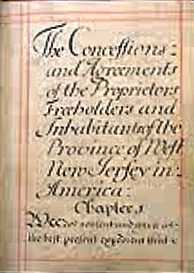
|
| Concessions and Agreements |
The United States Constitution is a unique achievement, but it had significant precursors, many of which James Madison had studied at Princeton. In the days of difficult ocean travel, almost all colonies were bound by an agreement to maintain loyalty to their European owners in spite of receiving latitude to govern themselves. Charters and documents defining these roles were generally written by the owners, and the colonists could pretty much take them or leave them. In the case of New Jersey in 1664, however, a very formidable lawyer and friend of the King named William Penn was drawing up agreements to his own conditions of sale, taking care that the grant of governing authority he received was favorable. Penn's relationship to the King was unusually good, to say the least. He had more reason to be wary of nit-pickers in the King's administration, trying to anticipate every conceivable disappointment for some successor King.
For his part, Penn wanted to make colonial land attractive to re-sell to religious groups who had experienced harsh government oppression; he wanted no obstacles to his announcing there would be no religious oppression in New Jersey. He was offered the role of sub-king although he hastily rejected any such title, and needed to repeat the formalities of the Charter to define his role and reassure his settlers about that matter. Furthermore, he was dealing with the heirs of Carteret and Berkeley, active participants in North and South Carolina. So Penn's method of achieving basic rights was influenced by prior thinking in the Carolinas, as the thinking of John Locke secondarily influenced matters in Delaware and Pennsylvania. These ideas were incorporated in a New Jersey document called "Concessions and Agreements." The concepts were not wholly the ideas of William Penn, but he did write it, and it does contain many ideas that were uniquely his. Understandings about limits were set down, argued about, and agreed to. The owner risked money, the colonist risked his life. Neither would agree unless a reasonable bargain was struck in advance of any dispute. Furthermore, the main value of a colony was beginning to shift from trading rights to real estate rights. Carteret and Berkeley had not only been principals in both the Carolinas and the Jerseys but had been involved in a number of such investments in Africa and the West Indies; New Jersey was just another business deal. It was conventional for documents of this type to define the method of selection of a governor, the establishment of an assembly of colonists, and some sort of council to attend to day to day affairs. In that era, few colonists would cross the ocean without a guarantee of religious freedom, at least for their own brand of religion. Standard clauses which may sound strange in today's real estate world, were then necessary because it was a transfer of not merely land, but also the terms of government. In the case of the Quaker colonies, many of these stipulations were included in the earlier charter from the King. It seems very likely that Penn hovered around and negotiated these points which he wished to have the King agree to; and then once the land was safely his, Penn repeated and expanded these stipulations with the colonists in his Concessions and Agreements . It wasn't exactly a Constitution, but it reads a lot like the one America adopted a century later.
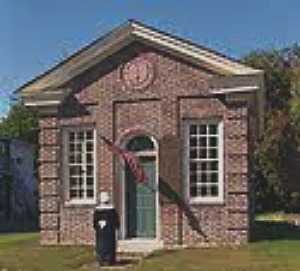
|
| Proprietors House |
Quakers had suffered persecution and imprisonment, and knew exactly what they feared; on the other side, it seems likely Carteret and Berkeley were less interested. So this real estate transfer document conceded almost anything the colonists wanted and the King would stand for, couched in conciliatory phrases. For example, no settler was to be molested for his conscience, and liberty was to be for all time, and for all men and Christians. Elections, by the way, must be annual, and by secret ballot. While law and order must prevail, nevertheless no man is to be imprisoned or molested except by the agreement of twelve men of the neighborhood. On the matter of slavery, no man was to be brought to the colony in bondage, save by his own consent (that is, indentured servants were to be permitted). And in what proved to be a final irony for William Penn, there was to be no imprisonment for debt. Almost all of these innovative ideas survived into the U.S. Constitution a century later, but the most innovative idea of all was to set them all down in a freely-made agreement in writing. This was not merely how a government was organized, it defined the set of conditions under which both sides agreed it would operate.
It was, of course, more than that. It was a set of reassurances to settlers who had been in New Jersey before the English arrived that they, also, would be treated as equals. It was a real estate advertisement to the fearful religious dissenters back in England that it was safe to live here. And it was a reminder to future Kings and Parliaments that this is what they had promised.
The pity and a warning, is that the larger vision of a whole continent governed fairly by common consent may have been too grandiose for a little band of New Jersey Quakers, surrounded as they were by an uncomprehending world. All utopias are helpless when stronger neighbors reject the basic premise. However, it was the expansion of the pacifist concept to the much larger neighboring territory of Pennsylvania that proved to be just too much for such a small group of friends to manage by consensus, particularly when unbelieving immigrants began to outnumber them. But the essential parts of it certainly remained in the minds of delegates to the Constitutional Convention in 1787. When the minutes of the Constitutional Convention speak of the "New Jersey Plan", the Concessions and Agreements was what they had in mind.
REFERENCES
| Concessions and Agreements of New Jersey 1676: William Penn | New Jersey State Library |
| Camden After the Fall: Decline and Renewal in a Post-Industrial City: Howard Gillette Jr.: ISBN-13: 978-0812219685 | Amazon |
Forming the State of Delaware
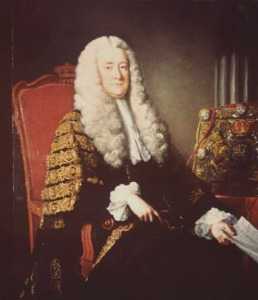
|
| Philip Yorke, Earl of Hardwicke |
When the Duke of York was within hours of being banished, he told his agent Sir John Werden to give the contested strip (now the state of Delaware) to Penn, but save out the town of Newcastle with a twelve-mile strip of land around it. Werden wrote that into the charter with a proviso based on the idea that the fortieth parallel was to the south of Newcastle, when in fact it was fifty miles north of it, and could not possibly conform to the stated boundaries. Both Penn and Baltimore learned the true situation in a year or two, and both attacked the other for dissembling ignorance, each seeking to take advantage of implausible arguments. What in fact they both discovered was that if the dividing line could be pushed a few miles south, Penn would acquire the mouth of the Susquehanna in the Chesapeake Bay, while if it went north a few miles, Maryland would acquire most of Philadelphia. Lord Hardwicke worked out a reasonable compromise which, while ignoring some plain language in the documents, eventually resulted in the Mason-Dixon line which is now reasonably comfortable for everybody, although first subjected to another two decades of wrangle.
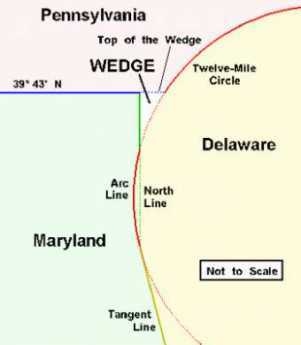
|
| Delaware Wedge |
Even part of the eventual compromise, a semicircular northern border, didn't come out right, resulting in a wedge of no-man's land. Landowners didn't enjoy paying disputed taxes, so they held up the settlement of the wrangle into the Twentieth Century. Eventually, the U.S. Supreme Court cut the wedge into two pieces, giving one piece each to Pennsylvania and Delaware. Meanwhile, disputes continued which had their basis in the way the semi-circular line was plotted out on the land. The surveyors ran 120 straight-line radii outward from the courthouse tower in Newcastle, and then connected the ends. Obviously, that resulted in 120 straight chords instead of a smooth semi-circle, and a couple of bulges had to be accommodated where the circle grazed other straight borders. The semi-circle crossed the Delaware River, so New Jersey helpfully abandoned its portion, only to regret its decision later when toll bridges were constructed, and ship channels deepened.

|
| King Charles I |
Two major societal changes took place between 1632 -- when Charles I granted the proprietorship of Maryland to the first Lord Baltimore -- and 1776 when all American real estate changed its rules. The first change was that the Delaware Bay morphed from a swamp into settlements of people; settlers came into possession. The second evolution was to the current view that if you sell some real estate it is no longer yours; in earlier eras, everything belonged to the king, who could take it away and give it to others as often as he pleased. In legal terms, the last king had the last word. Although acres of parchment were scribbled by lawyers pro and con, these considerations are what make clear how Lord Baltimore could hold the unchallenged legal title for fifty years to everything up to the fortieth parallel, but then have a court take away thousands of square miles. A land which was to become the three lower counties of Pennsylvania was given to William Penn by the Duke of York in 1682, using some flawed documents and only fully enjoyed by Penn's heirs for six years until they morphed into the new State of Delaware. From 1684 to 1769, legal ownership was a matter of continuing dispute. The exasperated Lord Chancellor (Hardwicke) in 1750 declared the case as one "of nature worthy of the judicature of a Roman senate rather than of a single judge".
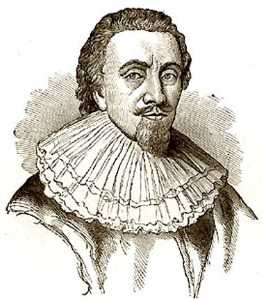
|
| Lord Baltimore |
Lord Baltimore had been given "unsettled" land, occupied only by savages. William Penn's lawyers struggled to prove the Dutch had settled the area before 1632, while Baltimore's lawyers sought to prove that pirates and wandering fur traders don't count, nor do villages of thirty people who were wiped out by the Indians. By the Doctrine of Discovery, taking land from pagans was encouraged, but taking land from Christians required special formalities. Since this Doctrine dates back before there were Protestants, it might have been pertinent to inquire whether the Dutch should be regarded as pagans, as the Spanish surely did when they suppressed Dutch independence in the Eighty Years War, ending in 1648.
Lord Baltimore advertised land along Delaware for sale to settlers while the matter was still under litigation. That was the foulest play said Penn, a weak argument to make if litigation was intentionally pursued for a century.
Maryland favored the Catholic cause, so it seemed plausible for them to want to stall, hoping the Catholic Duke of York would ascend to the throne. Under the new King James II, however, Baltimore seemed unlikely to prevail that the same person, as Duke of York, really didn't own the land he was trying to give to William Penn. So of course, Lord Baltimore claimed he never stalled.
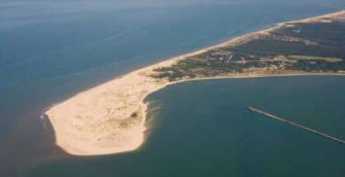
|
| Cape Henlopen |
And by the way, ocean currents moved Cape Henlopen a mile or so southward, but the real boundary problem was that common usage over the centuries confused Cape Henlopen with Fenwick's Island (to which it is usually attached by a thin barrier island), making an implicit difference in the Maryland/Delaware ownership of the corresponding strip of land at the southern border of the State of Delaware, a matter of a hundred or so square miles.
And all of this confusion was merely about the borders of one of the smallest of our fifty states. The political manner in which Delaware became a colony without a charter to the King, and became a state by gradual and mystifying degrees separate from the other counties of Pennsylvania are other complicated stories. Never mind the reasons Delaware remained in the Union during the Civil War, even though it also remained a slave state.
With gratitude to the memory of Dudley Cammett Lunt 1896-1981, whose books are a most readable but scholarly analysis of this complicated history. In particular, The Bounds of Delaware and, for the Mason-Dixon Line, Taylor's Gut in the Delaware State are recommended. The courts rejected arguments that the land was essentially wilderness when Lord Baltimore acquired his patent, and history has been sympathetic to Penn, the winner. The contention was the Dutch owned the land by right of discovery ( a Doctrine applied to land ruled by pagans by Pope Nicholas II in 1454), while the Duke of York later took it from the Dutch by surrender to force of arms -- another legally benign method of acquiring sovereignty. However, Lunt points out that a far more significant issue was the southern border of Pennsylvania in Penn's original grant, which asserted geographical impossibility to replace Maryland's plain and simply defined boundary. History has tended to regard this as understandable error, and subsequent legal quarrels to have been perpetuated by William Penn's greedy heirs. However, Lunt seems to reveal his own opinion of the affair by ending his book with a July 31, 1683 quotation from a letter by William Penn to Colonel Thomas Tailleur:
I, finding this place necessary to my Province and it ye Presence of Ld. Balt. was at Law, civil & common, I endeavoured to get it, & have it, & will keep it if I can.
The Proprietorships of William Penn
William Penn became first interested in the Colonies when he acquired New Jersey as an investor in what started out as the bankruptcy proceedings of a client. Unlike his spoiled children and grandchildren, he was sincerely interested in helping the persecuted members of his new religion, and those who later totaled up his lifetime finances found that overall he lost money on his real estate ventures. His descendants, however, were mainly concerned with selling real estate, and soon reverted to Anglican church membership. When William Penn later received Pennsylvania and Delaware from the King of England (Charles II, the Stuart King restored with the help of his Admiral father), he not only owned these territories but for practical administrative reasons was offered the right to rule them. By then Penn's main future intention was to found a refuge for Quakers and other religious dissenters, so becoming a vassal King was graciously declined. Instead, he became a real estate Proprietor, after satisfying himself about the government and other arrangements in only a general way. At least half the original 13 colonies were also proprietorships, although the terms of their grants had great variation. Penn's intention for the proprietorship was to sell off as much of the property as possible, sort of benignly watching the process unfold in the parts he had sold.
There were two unforeseen flaws in this benevolent idea; the first was that his sons and heirs would abandon the Quaker faith and have little interest in his holy experiment except for the revenue it returned. The second flaw was to fail to see that vigorous religious toleration might eventually lead to the Quakers becoming outnumbered in their own refuge. Eventually, there does come a time in the real estate sell-off process when you have sold more than you retain. After that point, you may no longer dominate the politics, and in fact, that happened far sooner than half-way, because of Penn's unwillingness to employ force .
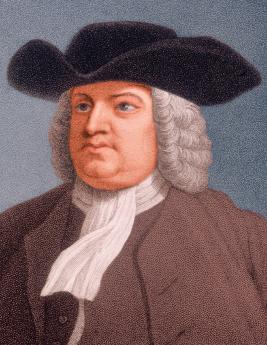
|
| William Penn |
In land value, although perhaps not in land area, that point of loss of control had been reached by the middle of the eighteenth century, and it led to a famous battle between the Penn descendants and Benjamin Franklin. The Penn family saw no justice in paying taxes on the land they hadn't yet sold, or obeying laws created by their customers which extended beyond the land they owned; if they wanted to rule it all, they should buy it all. Franklin took the part of the settlers and immigrants, who resented paying taxes and fighting Indians on behalf of someone who still owned vast stretches of the land "within" the colony. A significant factor in this peculiar argument is that Thomas Penn, the dominant chief of the family descendants, had a deep and abiding suspicion of Franklin, dating back to that episode related in Franklin's Autobiography where Franklin raised a militia in King George's War when the pacifist Quakers refused to do so. Both sides had some justice in their positions, both sides appealed to the King. The Penns knew the King better, so Franklin lost. That was mostly what Franklin was doing in London in the years before the Revolution, and eventually, it took a Revolutionary war to resolve the issue. Some have said the episode showed Franklin was not as shrewd a politician as history books would portray him. In fact, it more likely emphasizes that Franklin was a loyal British subject right up to 1775. His position was that all parties were and forever would be, inhabitants of the British Empire, so they had equality under British rule. The Penns felt they had a right to consider Pennsylvania their own sovereign property, under which the colonists had no rights until they paid for them. It is easy to see how the notion of independence could take hold in this curious reversal of roles. Nevertheless, Pennsylvania did resolve the issue with the appearance of lawfulness, although with restrained generosity. To quote Sydney G. Fisher, writing in The Quaker Colonies, "When the people could have confiscated everything in Pennsylvania belonging to the proprietary family, they not only left them in possession of a large part of their land but paid them handsomely for the part that was taken." The matter is generally considered to have been finally settled by the Confirming Act of 1787, although few would now contend that fifteen pennies per acre is or was a handsome price.
And so, the Pennsylvania proprietorship was dissolved. In New Jersey, on the other hand, the proprietorship still exists. The land between the North River (Hudson) and the South River (Delaware) was divided into two proprietorships by a line drawn between the Delaware Water Gap, and Beach Haven on Long Beach Island. The southern segment was called the Proprietorship of West Jersey, informally peopled by English Quakers, and a northern half, the Proprietorship of East Jersey, informally ceded to Scots Quakers who proved to be more Scottish than Quaker. Temperamental differences might well have eventually led the two segments to take opposite sides of the 1860 Civil War except that it was the northern half that sympathized with slavery and the Southern Confederacy, while the Proprietorship of West Jersey was mostly where the anti-slavery movement began, with a Quaker named John Woolman. As matters turned out, neither slavery nor taxing unsold land became irreconcilable issues in the Jerseys. Unsold land of the Proprietorship was already fairly minor in New Jersey at the time of the Revolution, but the issue hadn't been forgotten by the Proprietors, either. A couple of the stockholders of the proprietorship were members of the Constitutional Convention. When the time came that other delegates urgently needed New Jersey's vote to ratify the new constitution, the Proprietor problem was "explained" to the other states. The outcome was that the proprietorship tacitly agreed to be taxed and regulated like any other property owner, while their own rights were respected as persisting under the new Constitution. Such a sensible outcome was probably not possible in Pennsylvania because there was so much more unsold land to fight about. The peacefully accepted consequence in New Jersey, even today, is that when the ocean creates a new strip of beach or a farmer abandons some land on the other side of a turnpike, it reverts to the Proprietorship as undeeded and untitled land. As such, it legally belongs to a little group of stockholders who meet once a year in Burlington or Salem, under a tree, and who can actually pay themselves annual dividends. It is however only true in half the state; the Proprietorship of East Jersey surrendered its rights to the State in 1998.
In Delaware, things are a little fuzzier. Delaware was once part of Pennsylvania, as its lower three counties. John Dickinson was once Governor of both states, but they had two legislatures from 1700 to 1776. The last time the proprietorship matter came up, so far as real estate lawyers can remember, was in the shifting sandy beaches of Cape Henlopen; things were smoothed out by making the disputed land into a state park.
REFERENCES
| Encyclopedia of New Jersey | Google Books |
| The Problem of West Jersey | JSTOR |
| The Oxford History of the British Empire: The Origins of the Empire | Google Books |
| A Map of East and West New Jarsey | JPG |
| Council of Proprietors of West Jersey | westjersey.org |
| Magna Charta: Part I: The Romance of the Great Charter; Part II: Pedigrees of the Barons: John S. Wurts: SIN: AB0006D91C4 | Abe Books |
| West New Jersey: The Peculiar Province: ASIN: B00072HGTE | Amazon |
| Why the Private School?: Allan V. Heely: ASIN: B000GR1QS2 | Amazon |
3 Blogs
Concessions and Agreements
 Most 17th Century colonies were proprietorships, requiring agreements for local autonomy without losing allegiance to the home country. William Penn cleverly expanded the New Jersey document into the intellectual precursor of the U.S. Constitution.
Most 17th Century colonies were proprietorships, requiring agreements for local autonomy without losing allegiance to the home country. William Penn cleverly expanded the New Jersey document into the intellectual precursor of the U.S. Constitution.
Forming the State of Delaware
 In 1632, King Charles I granted to the Maryland proprietor coastal land with a northern border at the 40th parallel. In 1682, his son James the Duke of York evicted the Dutch from the Connecticut River to Cape Henlopen; afterward, his brother King Charles II gave away New Jersey and Pennsylvania, leaving York with New York plus a strip of wilderness from Pennsylvania to Henlopen. York then gifted that southern strip to William Penn before anyone realized there was a sloppy overlap with Maryland of thousands of square miles. Lawsuits are galore.
In 1632, King Charles I granted to the Maryland proprietor coastal land with a northern border at the 40th parallel. In 1682, his son James the Duke of York evicted the Dutch from the Connecticut River to Cape Henlopen; afterward, his brother King Charles II gave away New Jersey and Pennsylvania, leaving York with New York plus a strip of wilderness from Pennsylvania to Henlopen. York then gifted that southern strip to William Penn before anyone realized there was a sloppy overlap with Maryland of thousands of square miles. Lawsuits are galore.
The Proprietorships of William Penn
 William Penn owned Pennsylvania, New Jersey, and Delaware; as the proprietor, he was the largest private American landowner, ever. Although the Revolutionary War mostly ended that, one of his proprietorships still owns all unclaimed land in southern New Jersey.
William Penn owned Pennsylvania, New Jersey, and Delaware; as the proprietor, he was the largest private American landowner, ever. Although the Revolutionary War mostly ended that, one of his proprietorships still owns all unclaimed land in southern New Jersey.